An Experimental Study on the Seepage Characteristics of Rough Fractures in Coal under Stress Loading
Abstract
1. Introduction
2. Seepage Test on Rough Fractures in Coal under Stress Loading
2.1. Sample Preparation
2.2. Fracture Structure of the Sample
2.3. Test Scheme
3. Analysis of Test Results
3.1. Flow–Pressure Gradient Curve
3.2. Nonlinear Seepage Characteristics Based on the Forchheimer Equation
3.3. Nonlinear Seepage Characteristics Based on the Izbash Equation
3.4. Discussion
4. Conclusions
- (1)
- Under stress loading, the gas flow patterns in rough fractures in coal show obvious nonlinear seepage characteristics, and the nonlinearity gradually increases with increasing effective stress and gas pressure gradient.
- (2)
- When the Forchheimer equation is used to characterize gas transport in the rough fracture, the coefficients a and b increase gradually with increasing effective stress, and the relationship between the permeability and the effective stress is a monotonically inverse power function. The nonlinear factor Pr and critical Reynolds number Rec can effectively determine the degree of nonlinear flow due to inertial effects, and both gradually decrease with increasing effective stress.
- (3)
- The Izbash equation was used to characterize the gas transport in the rough fractures. The linear coefficient λ ranged from 1015 to 1016 for the four samples, and the nonlinear coefficient m ranged from 1.064 to 1.795. This coefficient had a power relationship with the effective stress. When the effective stress was gradually loaded, the equivalent hydraulic aperture of the four coal samples was inversely proportional to the effective stress.
- (4)
- Both the Forchheimer and Izbash equations can characterize the flow in rough fractures in coal during stress loading. However, the Forchheimer equation better reveals the mechanism of transformation of fluid flow from linear to nonlinear in rough fractures when determining the degree of nonlinearity.
Author Contributions
Funding
Data Availability Statement
Conflicts of Interest
References
- Luo, Y.; Xia, B.; Li, H.; Hu, H.; Wu, M.; Ji, K. Fractal permeability model for dual-porosity media embedded with natural tortuous fractures. Fuel 2021, 295, 120610. [Google Scholar] [CrossRef]
- Wang, Z.; Fu, X.; Pan, J.; Deng, Z. Effect of N2/CO2 injection and alternate injection on volume swelling/shrinkage strain of coal. Energy 2023, 275, 127377. [Google Scholar] [CrossRef]
- Li, Q.; Wang, F.; Wang, Y.; Forson, K.; Cao, L.; Zhang, C.; Zhou, C.; Zhao, B.; Chen, J. Experimental investigation on the high-pressure sand suspension and adsorption capacity of guar gum fracturing fuid in low-permeability shale reservoirs: Factor analysis and mechanism disclosure. Environ. Sci. Pollut. Res. 2022, 29, 53050–53062. [Google Scholar] [CrossRef] [PubMed]
- Chen, L.; Zhao, M.; Li, X.; Liu, Y. Impact research of CH4 replacement with CO2 in hydrous coal under high pressure injection. Min. Miner. Depos. 2022, 16, 121–126. [Google Scholar] [CrossRef]
- Mi, W.; Wen, H.; Fan, S.; Wang, S.; Wu, X.; Wei, G.; Liu, B.; Li, R.; Cheng, X.; Liu, M. Correlation analysis of injection parameters for low-medium pressure injection of liquid CO2 for CH4 displacement in coal seams. Energy 2023, 278, 127760. [Google Scholar] [CrossRef]
- Li, Q.; Liu, J.; Wang, S.; Guo, Y.; Han, X.; Li, Q.; Cheng, Y.; Dong, Z.; Li, X.; Zhang, X. Numerical insights into factors affecting collapse behavior of horizontal wellbore in clayey silt hydrate-bearing sediments and the accompanying control strategy. Ocean Eng. 2024, 297, 117029. [Google Scholar] [CrossRef]
- Niya, S.M.R.; Selvadurai, A.P.S. Correlation of joint roughness coefficient and permeability of a fracture. Int. J. Rock Mech. Min. Sci. 2019, 113, 150–162. [Google Scholar] [CrossRef]
- Klimczak, C.; Schultz, R.A.; Reeves, P.D.M. Cubic law with aperture-length correlation: Implications for network scale fluid flow. Hydrogeol. J. 2010, 18, 851–862. [Google Scholar] [CrossRef]
- Zou, L.; Jing, L.; Cvetkovic, V. Roughness decomposition and nonlinear fluid flow in a single rock fracture. Int. J. Rock Mech. Min. Sci. 2015, 75, 102–118. [Google Scholar] [CrossRef]
- Yin, Q.; He, L.; Jing, H.; Zhu, D. Quantitative Estimates of Nonlinear Flow Characteristics of Deformable Rough-Walled Rock Fractures with Various Lithologies. Processes 2018, 6, 149. [Google Scholar] [CrossRef]
- Valdez, A.V.; Morel, S.; Marache, A.; Hinojosa, M.; Riss, J. Influence of fracture roughness and micro-fracturing on the mechanical response of rock joints: A discrete element approach. Int. J. Fract. 2018, 213, 87–105. [Google Scholar] [CrossRef]
- Guo, T.; Zhang, S.; Gao, J.; Zhang, J.; Yu, H. Experimental Study of Fracture Permeability for Stimulated Reservoir Volume (SRV) in Shale Formation. Transp. Porous Media 2013, 98, 525–542. [Google Scholar] [CrossRef]
- Javadi, M.; Sharifzadeh, M.; Shahriar, K.; Mitani, Y. Critical Reynolds number for nonlinear flow through rough-walled fractures: The role of shear processes. Water Resour. Res. 2014, 50, 1789–1804. [Google Scholar] [CrossRef]
- Singh, K.K.; Singh, D.N.; Ranjith, P.G. Laboratory Simulation of Flow through Single Fractured Granite. Rock Mech. Rock Eng. 2014, 48, 987–1000. [Google Scholar] [CrossRef]
- Su, X.; Zhou, L.; Li, H.; Xia, B.; Shen, Z.; Lu, Y. Experimental and Numerical Modelling of Nonlinear Flow Behavior in Single Fractured Granite. Geofluids 2019, 2019, 1–20. [Google Scholar] [CrossRef]
- Li, H.; Lu, Y.; Zhou, L.; Tang, J.; Han, S.; Ao, X. Experimental and Model Studies on Loading Path-Dependent and Nonlinear Gas Flow Behavior in Shale Fractures. Rock Mech. Rock Eng. 2017, 51, 227–242. [Google Scholar] [CrossRef]
- Xia, B.; Ji, K.; Luo, Y.; Liu, S.; Hu, H. Nonlinear gas flow characteristics of acidified and water-saturated sandstone. Arab. J. Geosci. 2021, 14, 2260. [Google Scholar] [CrossRef]
- Forchheimer, P.H. Wasserbewegung durch boden. Z. Des Vereines Dtsch. Ing. 1901, 49, 1736–1749. [Google Scholar]
- Irmay, S. On the theoretical derivation of Darcy and Forchheimer formulas. Trans. Am. Geophys. Union. 1958, 39, 702–907. [Google Scholar]
- Chen, Y.; Zhou, J.; Hu, S.; Hu, R.; Zhou, C. Evaluation of Forchheimer equation coefficients for non-Darcy flow in deformable rough-walled fractures. J. Hydrol. 2015, 529, 993–1006. [Google Scholar] [CrossRef]
- Qian, X.; Xia, C.; Gui, Y. Quantitative Estimates of Non-Darcy Groundwater Flow Properties and Normalized Hydraulic Aperture through Discrete Open Rough-Walled Joints. Int. J. Geomech. 2018, 18, 04018099. [Google Scholar] [CrossRef]
- Shen, Z.; Zhou, L.; Su, X.; Li, H.; Tang, J.; Zheng, X. An experimental investigation of the nonlinear gas flow and stress-dependent permeability of shale fractures. Energy Sci. Eng. 2020, 8, 2808–2822. [Google Scholar] [CrossRef]
- Oda, M. An equivalent continuum model for coupled stress and fluid flow analysis in jointed rock masses. Water Resour. Res. 1986, 22, 1845–1856. [Google Scholar] [CrossRef]
- Luo, Y.; Zhu, Y.; Huang, F.; Xia, B. Experimental study on nonlinear seepage characteristics of coal under true triaxial stress loading. Phys. Fluids 2023, 35, 023111. [Google Scholar] [CrossRef]
- Wang, F.; Cheng, H. A fractal permeability model for 2D complex tortuous fractured porous media. J. Pet. Sci. Eng. 2020, 188, 106938. [Google Scholar] [CrossRef]
- Barton, N.; Choubey, V. The shear strength of rock joints and practice. Rock Mech. 1977, 10, 1–54. [Google Scholar] [CrossRef]
- Li, Y.; Zhang, Y. Quantitative estimation of joint roughness coefficient using statistical parameters. Int. J. Rock Mech. Min. Sci. 2015, 77, 27–35. [Google Scholar] [CrossRef]
- Luo, Y.; Wang, Y.; Guo, H.; Liu, X.; Luo, Y.; Liu, Y. Relationship between joint roughness coefficient and statistical roughness parameters and its sensitivity to sampling interval. Sustainability 2022, 14, 13597. [Google Scholar] [CrossRef]
- Jang, H.; Kang, S.; Jang, B. Determination of joint roughness coefficients using roughness parameters. Rock Mech. Rock Eng. 2014, 47, 2061–2073. [Google Scholar] [CrossRef]
- Yong, R.; Ye, J.; Liang, Q.; Huang, M.; Du, S. Estimation of the joint roughness coefficient (JRC) of rock joints by vector similarity measures. Bull. Eng. Geol. Environ. 2017, 77, 735–749. [Google Scholar] [CrossRef]
- Biot, M.A. General theory of three-dimensional consolidation. J. Appl. Phys. 1941, 12, 155–164. [Google Scholar] [CrossRef]
- Terzaghi, K.T. Theoretical Soil Mechanics; John Wiley & Sons, Inc.: Hoboken, NJ, USA, 1943. [Google Scholar]
- Crandall, D.; Bromhal, G.; Karpyn, Z.T. Numerical simulations examining the relationship between wall-roughness and fluid flow in rock fractures. Int. J. Rock Mech. Min. Sci. 2021, 47, 784–796. [Google Scholar] [CrossRef]
- Zhang, Z.; Nemcik, J. Fluid flow regimes and nonlinear flow characteristics in deformable rock fractures. J. Hydrol. 2013, 477, 139–151. [Google Scholar] [CrossRef]
- Zimmerman, R.W.; Bodvarsson, G.S. Hydraulic conductivity of rock fractures. Transp. Porous Media 1994, 23, 1–30. [Google Scholar]
- Xia, Z.; Zhang, X.; Yao, C.; Chen, H.; Yang, J.; Jiang, Q.; Zhou, C. Experimental studies on seepage characteristics during the loading and unloading confining pressure of post-peak fractured rock. J. China Coal Soc. 2019, 44, 3379–3387. [Google Scholar]
- Konzuk, J.S.; Kueper, B.H. Evaluation of cubic law based models describing single-phase flow through a rough-walled fracture. Water Resour. Res. 2004, 40. [Google Scholar] [CrossRef]
- Zhang, Y.; Chai, J. Effect of surface morphology on fluid flow in rough fractures: A review. J. Nat. Gas Sci. Eng. 2020, 79, 103343. [Google Scholar] [CrossRef]
- Zhang, Z.; Nemcik, J.; Qiao, Q.; Geng, X. A model for water flow through rock fractures based on friction factor. Rock Mech. Rock Eng. 2014, 48, 559–571. [Google Scholar] [CrossRef]
- Li, H.; Tang, J.; Lu, Y.; Zhou, L.; Han, S.; Dai, R. Experimental measurements of shale fracture conductivity under cyclic loading. Arab. J. Sci. Eng. 2017, 43, 6315–6324. [Google Scholar] [CrossRef]
- Chen, Y.; Liu, M.; Hu, S.; Zhou, C. Non-Darcy’s law-based analytical models for data interpretation of high-pressure packer tests in fractured rocks. Eng. Geol. 2015, 199, 91–106. [Google Scholar] [CrossRef]
- Chen, Y.; Hu, S.; Hu, R.; Zhou, C. Estimating hydraulic conductivity of fractured rocks from high-pressure packer tests with an Izbash’s law-based empirical model. Water Resour. Res. 2015, 51, 2096–2118. [Google Scholar] [CrossRef]
- Wen, Z.; Huang, G.; Zhan, H. Non-Darcian flow in a single confined vertical fracture toward a well. J. Hydrol. 2006, 330, 698–708. [Google Scholar] [CrossRef]
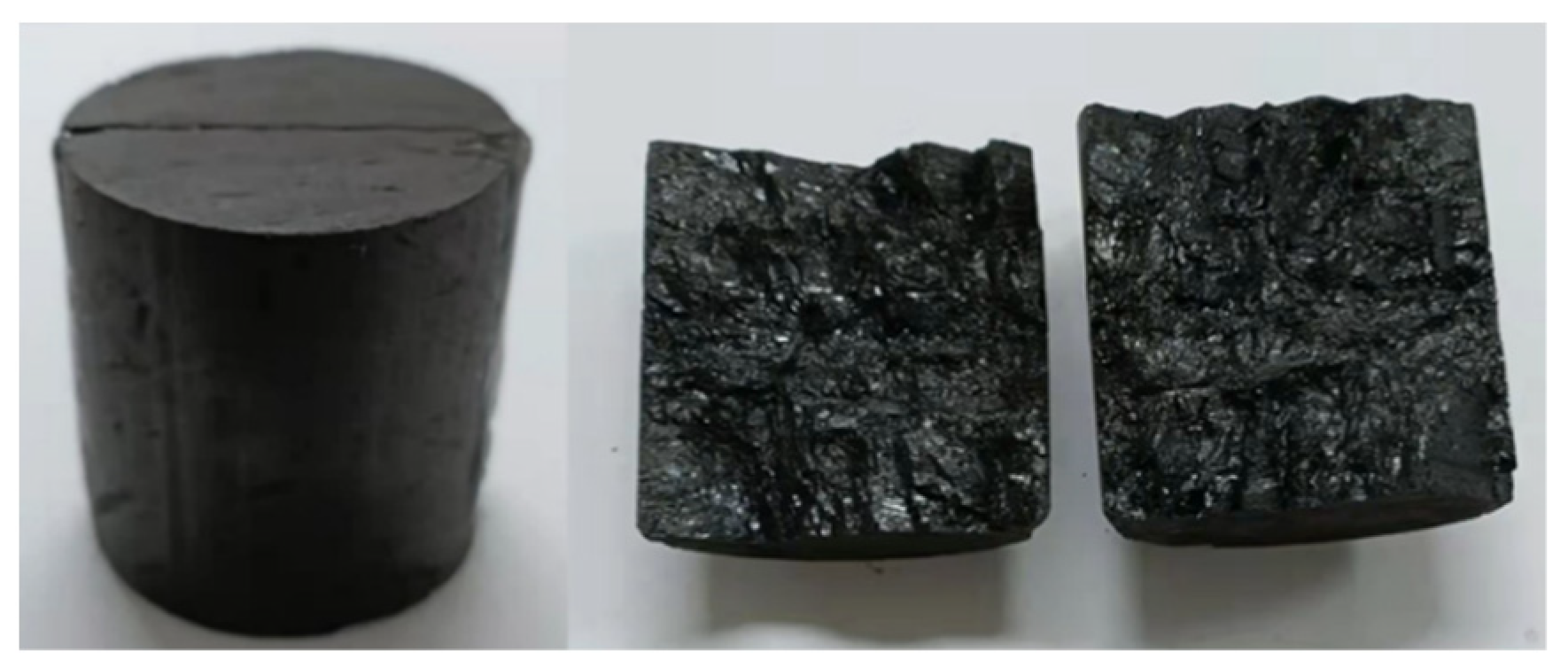

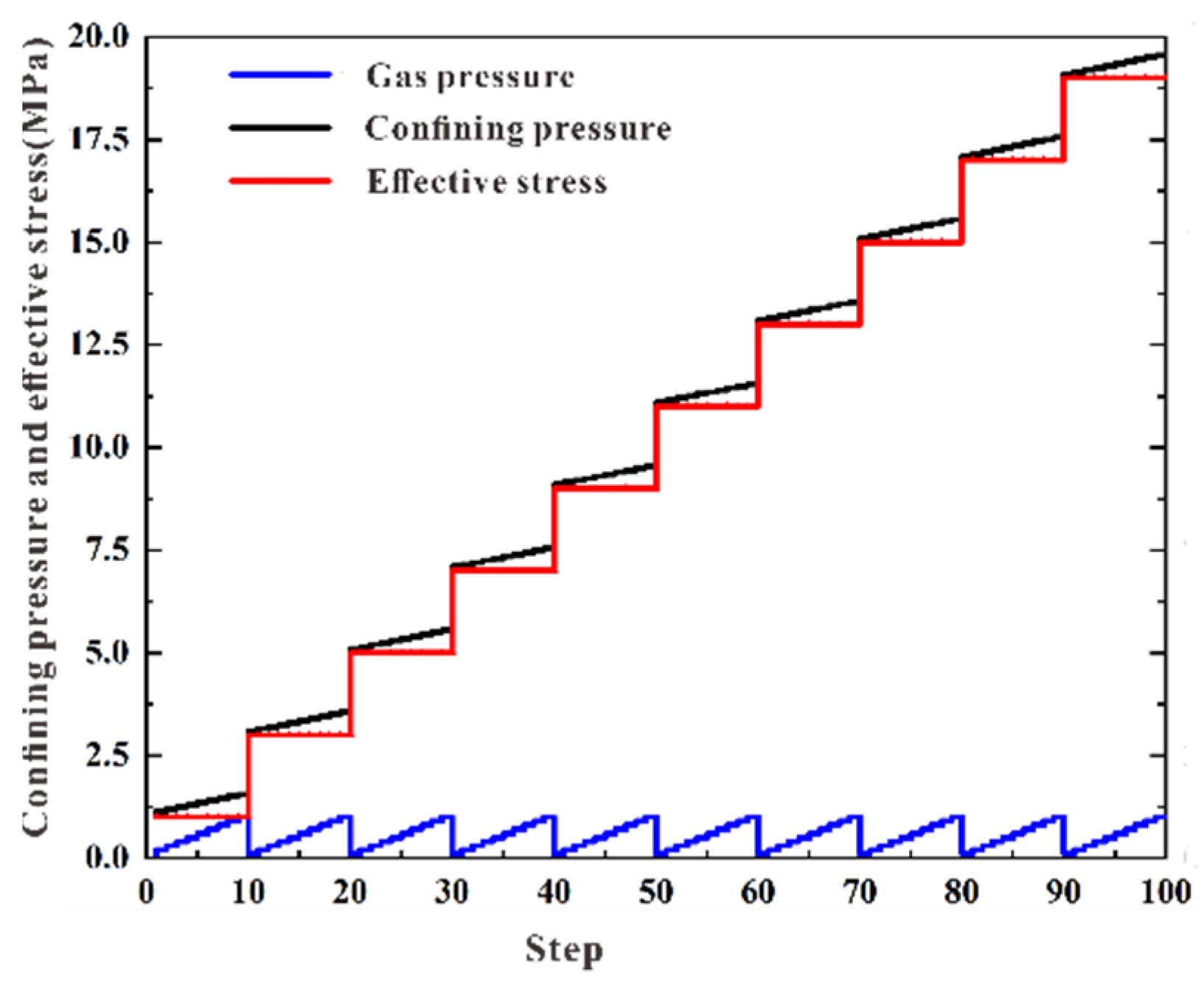

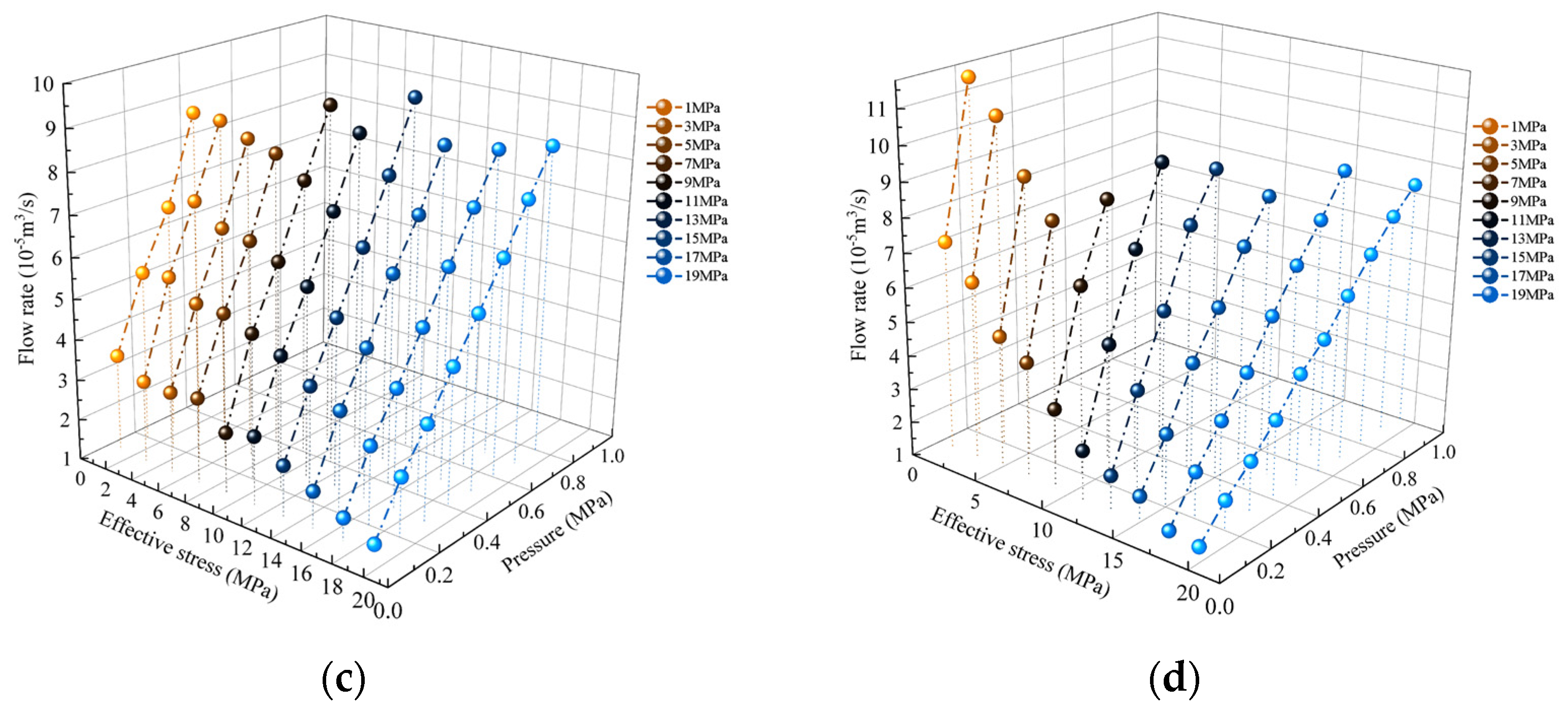
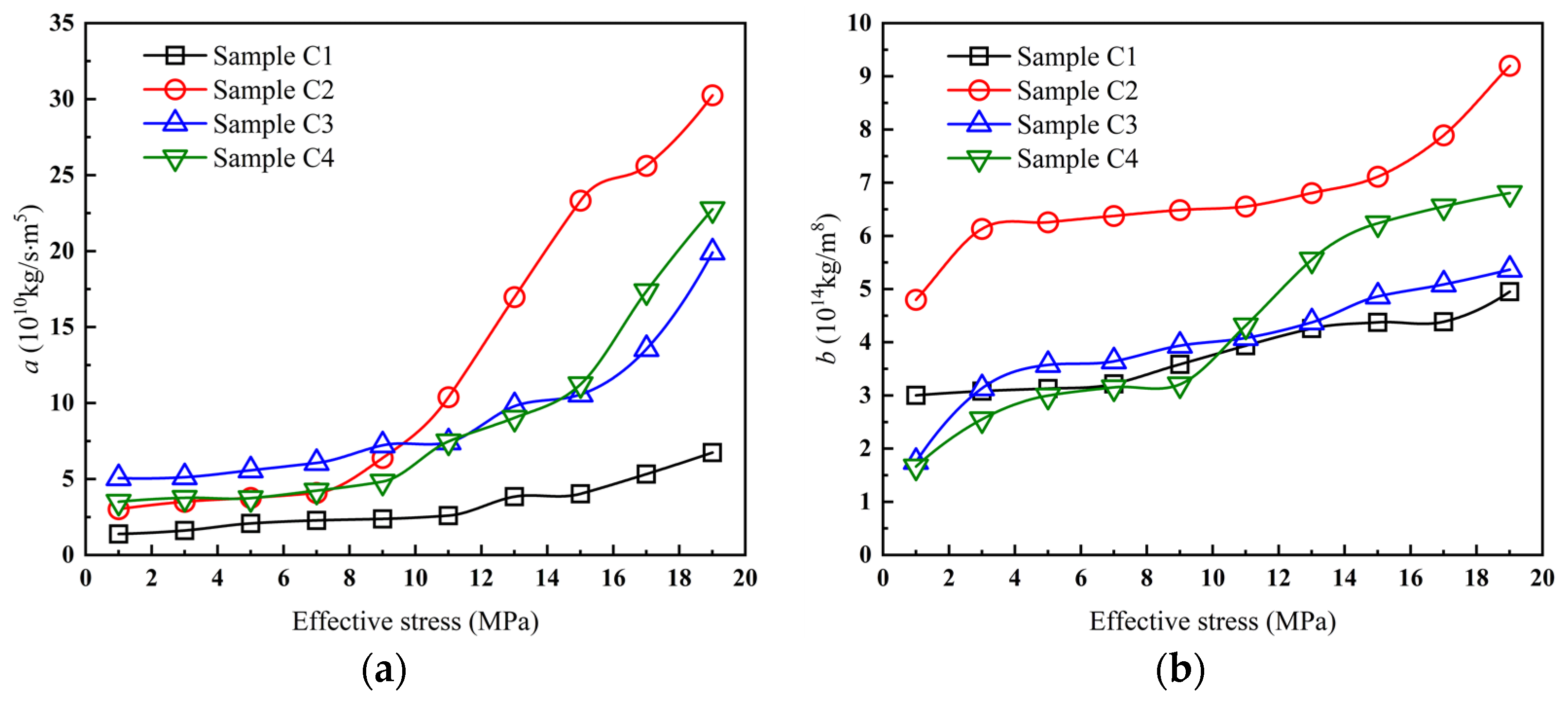
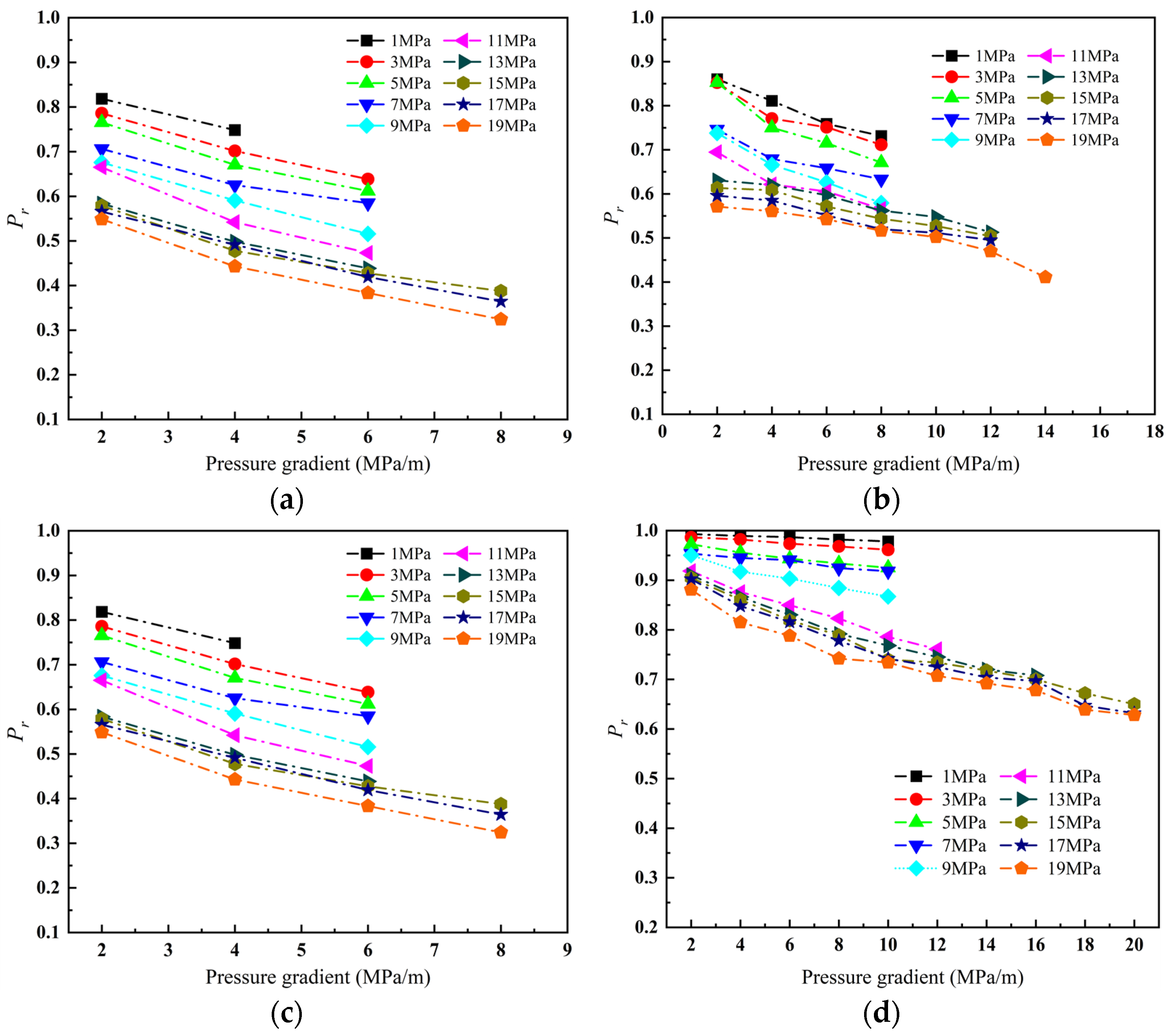
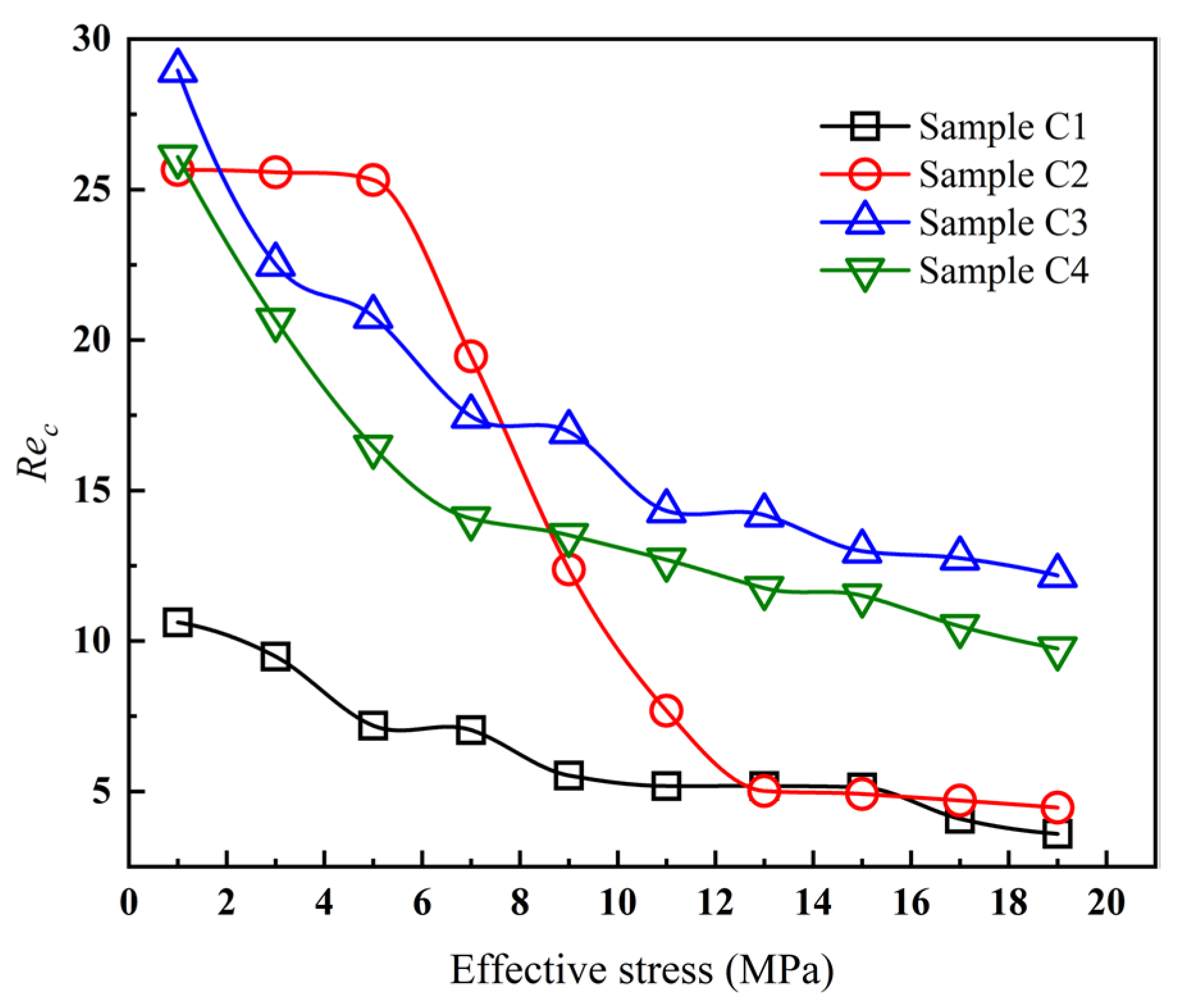
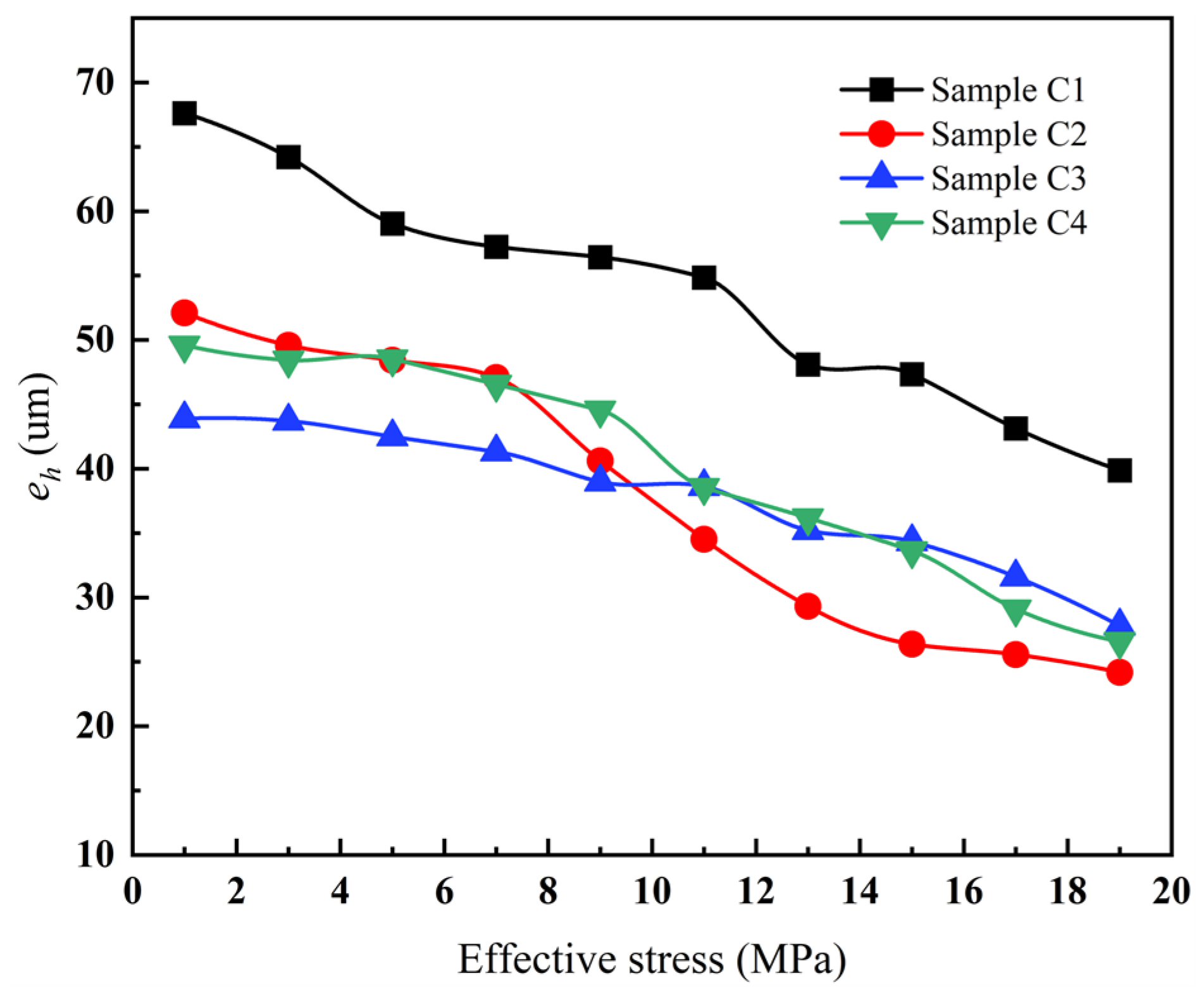
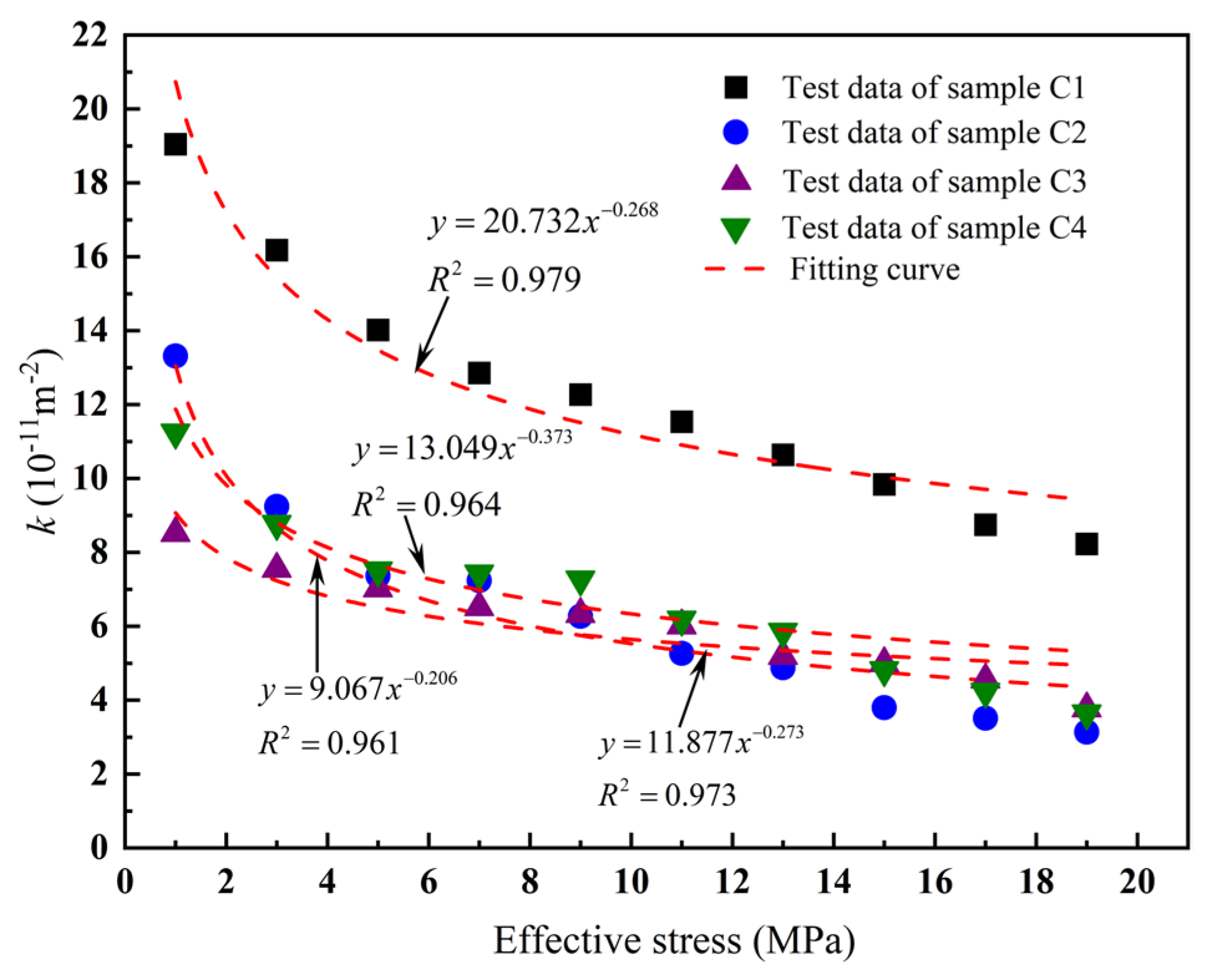
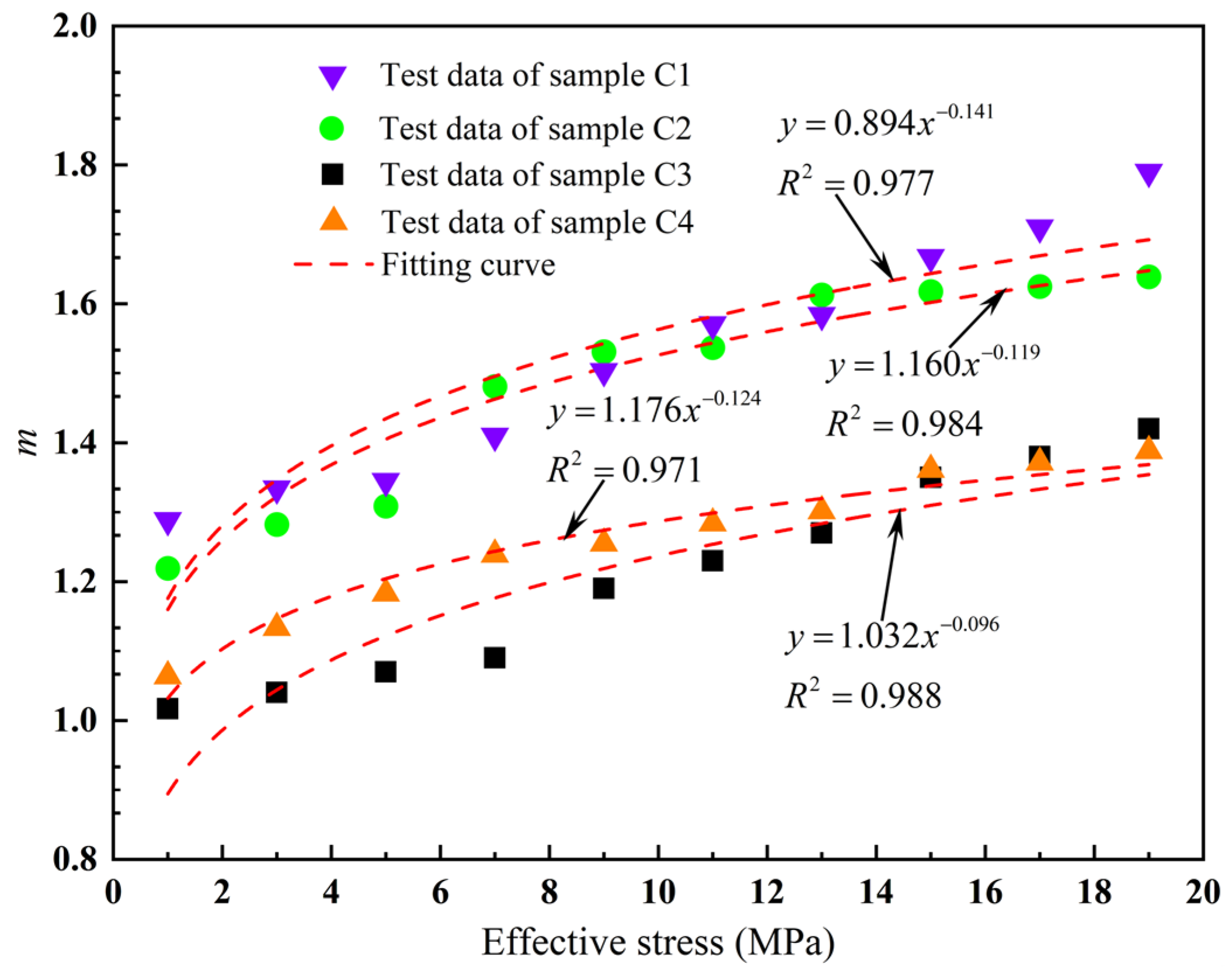

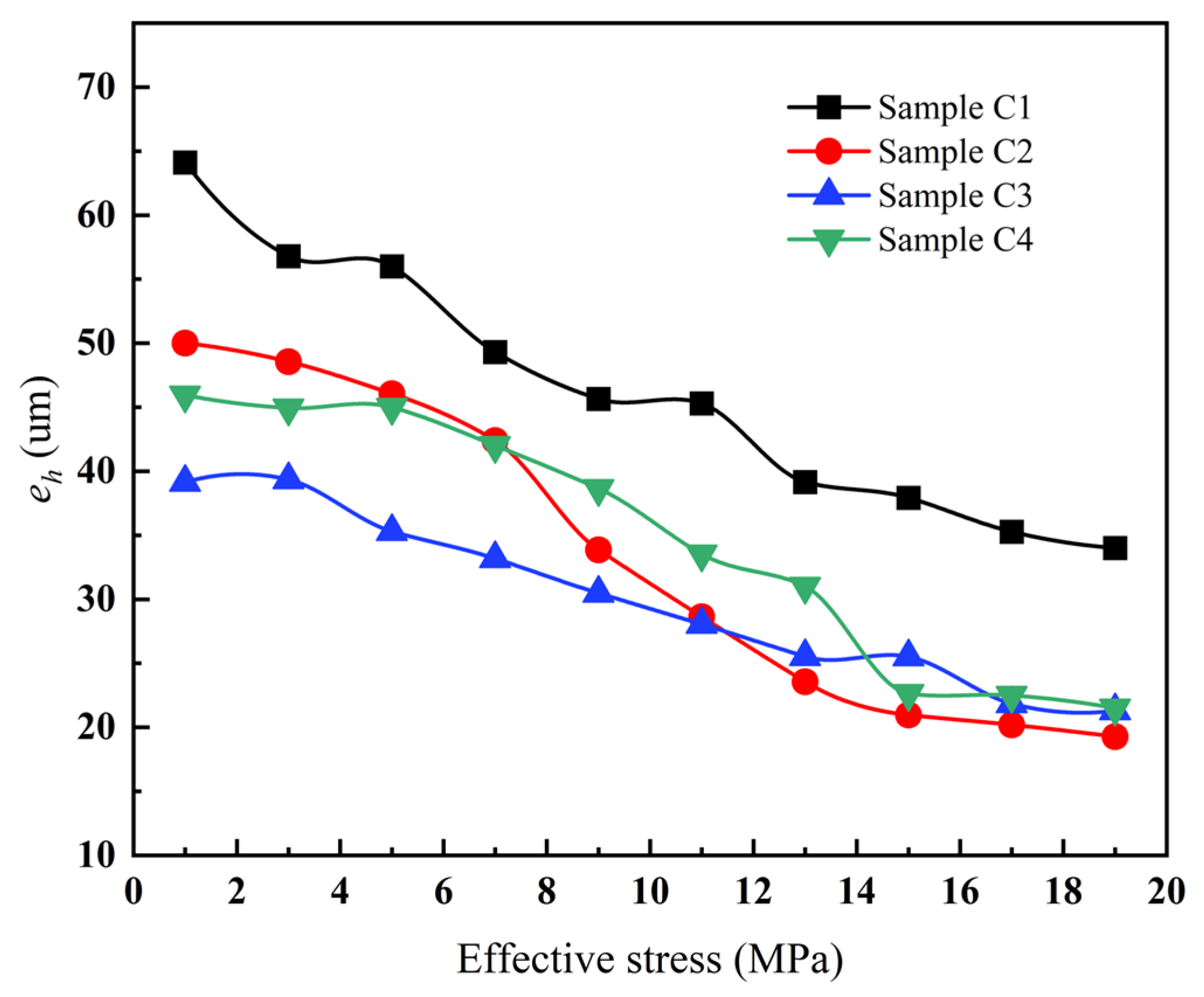
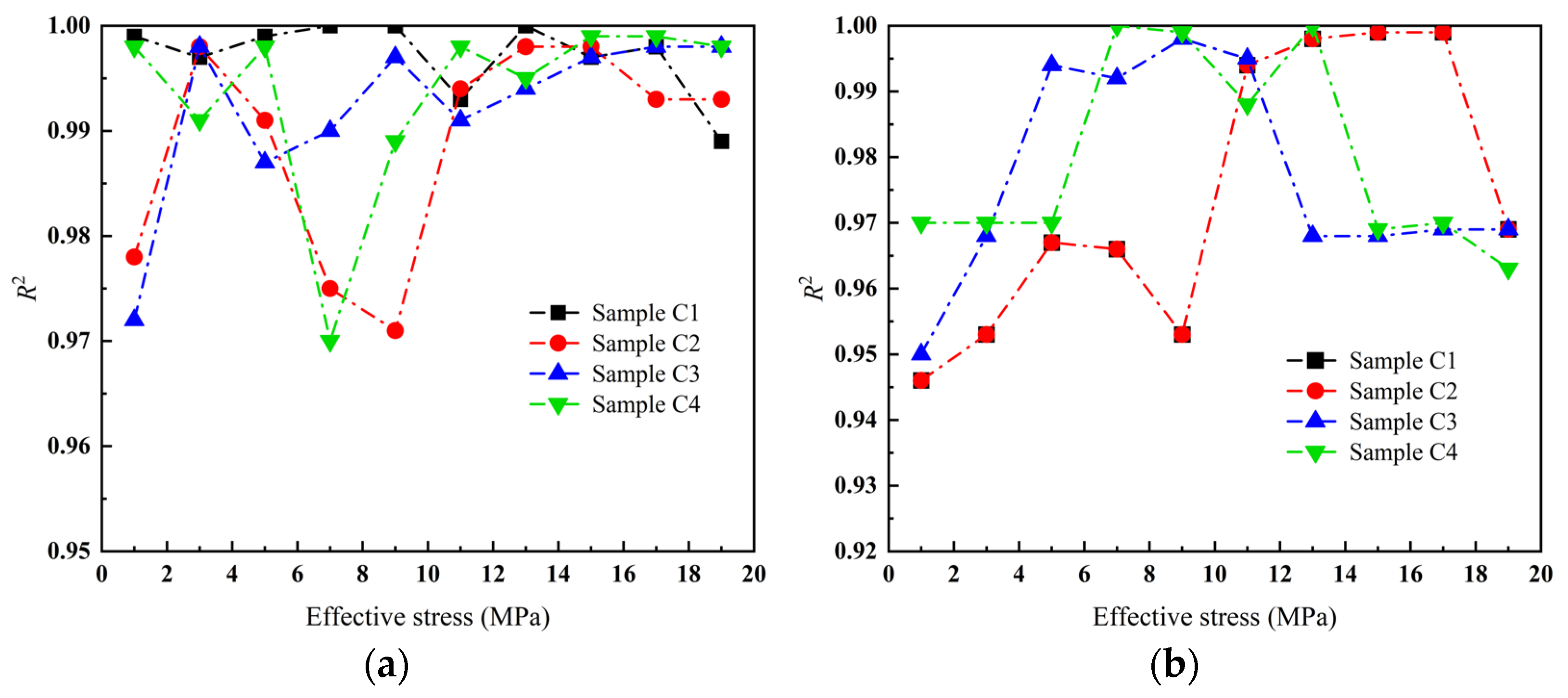
| Sample Number | Effective Stress/MPa | λ (1015) | m | R2 |
|---|---|---|---|---|
| C1 | 1 | 3.878 | 1.288 | 0.950 |
| 3 | 4.136 | 1.334 | 0.968 | |
| 5 | 4.118 | 1.345 | 0.994 | |
| 7 | 5.015 | 1.41 | 0.992 | |
| 9 | 6.369 | 1.503 | 0.998 | |
| 11 | 8.088 | 1.571 | 0.995 | |
| 13 | 9.964 | 1.584 | 0.968 | |
| 15 | 22.617 | 1.667 | 0.968 | |
| C2 | 1 | 2.868 | 1.219 | 0.969 |
| 3 | 4.238 | 1.282 | 0.983 | |
| 5 | 4.671 | 1.309 | 0.994 | |
| 7 | 5.232 | 1.481 | 0.996 | |
| 9 | 8.537 | 1.537 | 0.962 | |
| 11 | 11.233 | 1.531 | 0.970 | |
| 13 | 16.548 | 1.618 | 0.965 | |
| 15 | 18.135 | 1.613 | 0.968 | |
| C3 | 1 | 7.131 | 1.064 | 0.946 |
| 3 | 6.861 | 1.133 | 0.953 | |
| 5 | 9.728 | 1.183 | 0.967 | |
| 7 | 12.835 | 1.239 | 0.966 | |
| 9 | 18.523 | 1.255 | 0.953 | |
| 11 | 19.368 | 1.284 | 0.994 | |
| 13 | 25.703 | 1.302 | 0.998 | |
| 15 | 25.754 | 1.361 | 0.999 | |
| C4 | 1 | 1.622 | 1.017 | 0.970 |
| 3 | 2.332 | 1.04 | 0.970 | |
| 5 | 2.433 | 1.072 | 0.970 | |
| 7 | 3.567 | 1.091 | 1.000 | |
| 9 | 4.493 | 1.192 | 0.999 | |
| 11 | 4.596 | 1.235 | 0.988 | |
| 13 | 7.115 | 1.273 | 1.000 | |
| 15 | 10.864 | 1.429 | 0.963 |
Disclaimer/Publisher’s Note: The statements, opinions and data contained in all publications are solely those of the individual author(s) and contributor(s) and not of MDPI and/or the editor(s). MDPI and/or the editor(s) disclaim responsibility for any injury to people or property resulting from any ideas, methods, instructions or products referred to in the content. |
© 2024 by the authors. Licensee MDPI, Basel, Switzerland. This article is an open access article distributed under the terms and conditions of the Creative Commons Attribution (CC BY) license (https://creativecommons.org/licenses/by/4.0/).
Share and Cite
Luo, Y.; Zhu, Y.; Huang, F. An Experimental Study on the Seepage Characteristics of Rough Fractures in Coal under Stress Loading. Processes 2024, 12, 757. https://doi.org/10.3390/pr12040757
Luo Y, Zhu Y, Huang F. An Experimental Study on the Seepage Characteristics of Rough Fractures in Coal under Stress Loading. Processes. 2024; 12(4):757. https://doi.org/10.3390/pr12040757
Chicago/Turabian StyleLuo, Yafei, Yongjian Zhu, and Fei Huang. 2024. "An Experimental Study on the Seepage Characteristics of Rough Fractures in Coal under Stress Loading" Processes 12, no. 4: 757. https://doi.org/10.3390/pr12040757
APA StyleLuo, Y., Zhu, Y., & Huang, F. (2024). An Experimental Study on the Seepage Characteristics of Rough Fractures in Coal under Stress Loading. Processes, 12(4), 757. https://doi.org/10.3390/pr12040757





